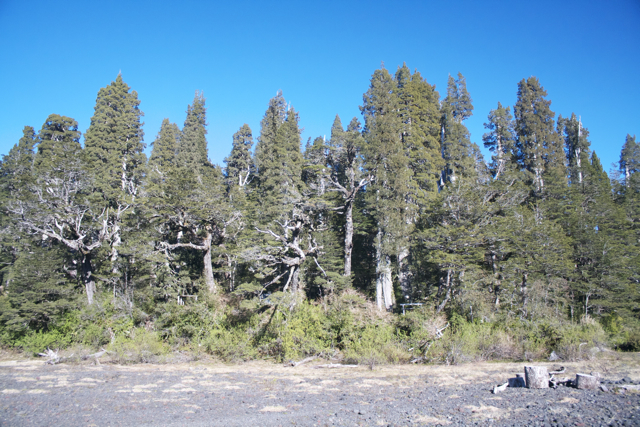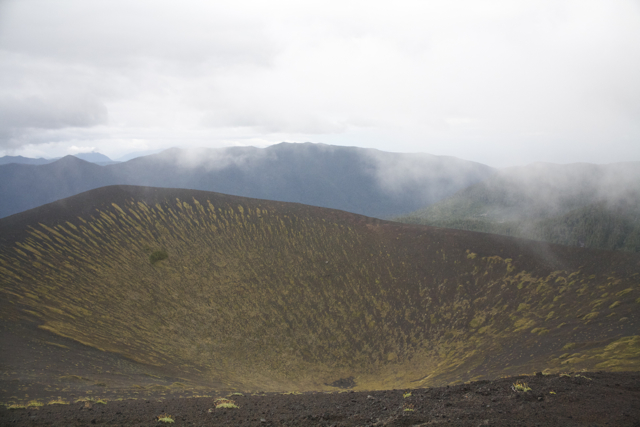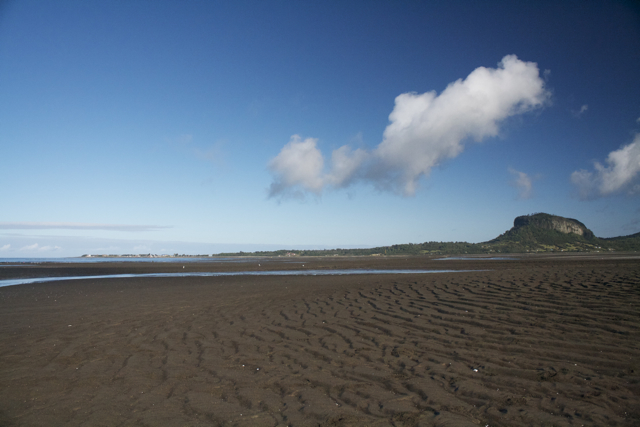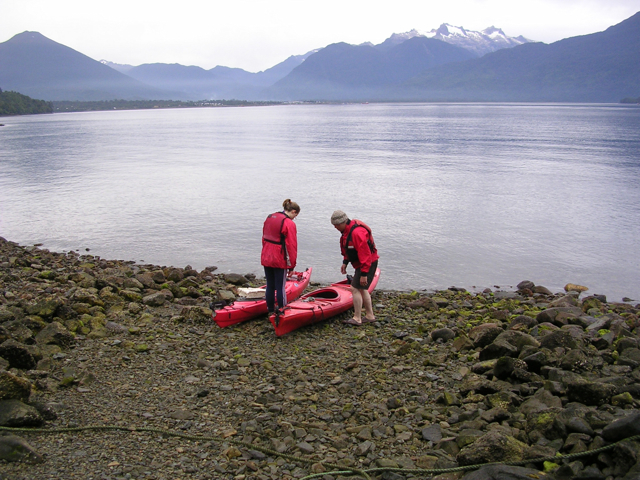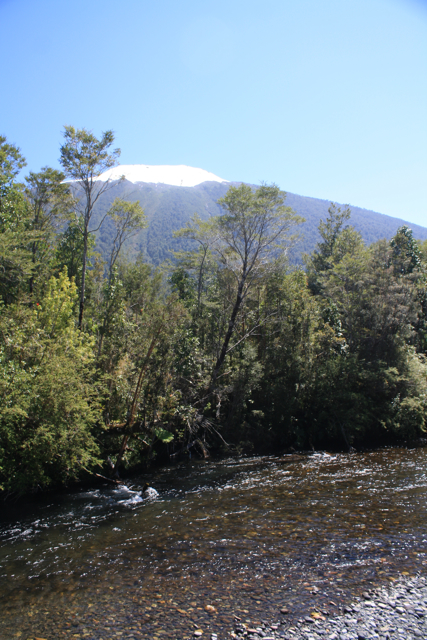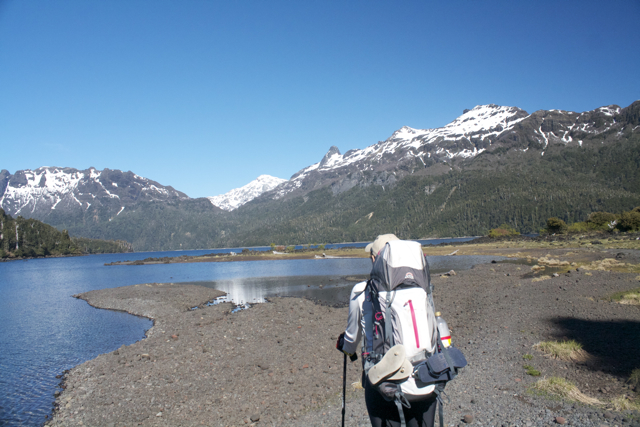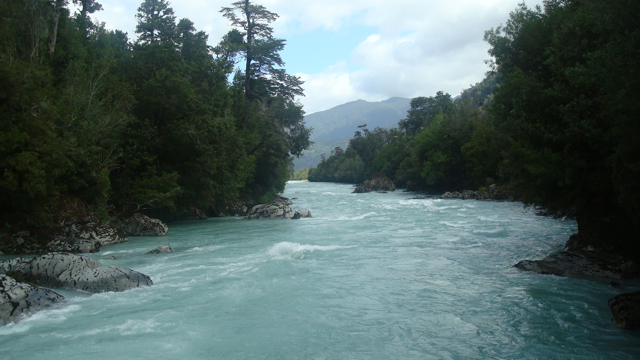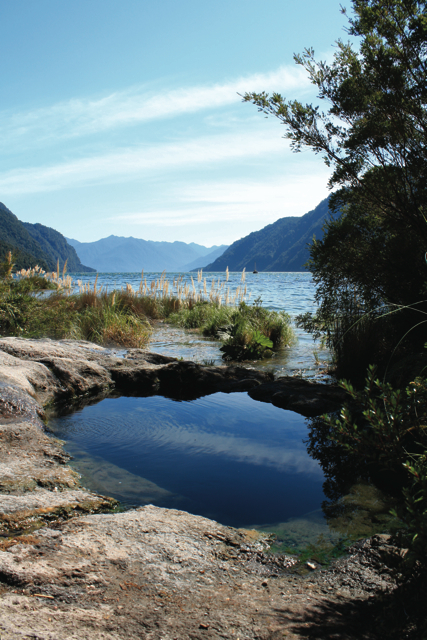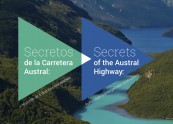By Marian Zink P.
From Río Puelo town, following the incursion road that borders the Reloncaví Estuary to the south, you’ll reach Puelche, entry point to the Hualaihué commune and the place where ferries that cross the Reloncaví Estuary arrive every 45 minutes.
From there you can take the extension of Ruta 7, most commonly known as Carretera Austral (Austral Highway). After approximately 6 miles you will reach the town of Contao and here you will have to decide whether to head straight to Hornopirén throughout the Carretera Austral or if you want to give the W-609, commonly known as the “Ruta Costera” (coastal road), a chance.
If you decide to continue through the Carretera Austral, roughly 3 miles away, you will find the entrance to the Apagado Volcano. Since this is private territory visitors must enter in the company of an authorized guide (ask in Contao). You can approach this 1200 meters high volcano driving a 4×4 vehicle through a beautiful yet tortuous two hour road, surrounded by Alerces and Cipreses trees. Then, after a 15 minutes trek, you will be able to reach the crater. If you get there on a sunny day, you can see the summits of the Osorno, Calbuco, Tronador, Yates, Hornopirén and Michinmahuida volcanoes.
The charming coastal road
We absolutely recommend this road, whether by car or mountain bike, you will be able to closely grasp the rural lifestyle in the different artisanal fisherman villages; such as La Poza, Aulen, Tentelhué, Rolecha, Lleguimán and Hualaihué Puerto amongst others, all known by their boat builders, both sail and motorized.
There are camping zones in the area and also locals that receive the tourists in their houses, sharing their traditions, such as the mate, tortillas or the locally made apple cider (chicha). If you see fisherman unloading their catch of the day don’t miss the opportunity to buy them fresh hake fish.
On the small villages near the shore, live nearly half of the 8000 inhabitants of Hualaihué. This commune is quickly growing in terms of basic infrastructure; one of its main achievements being the paving of the Ruta 7 in this area, currently under construction.
Close to the end of this road, in the Hualaihué Estero sector, you will find Cerro Silla, an imposing rocky structure that can be climbed after an hour of low difficulty trekking. On the top you can enjoy a magnificent view of the area, characterized by the flamingos that visit it on certain seasons of the year.
If you take the coastal road, you will return to the Carretera Austral in the area of El Varal, here you will see an old school that in the seventies was used by the military as an operation base for the construction of the Ruta 7.
Following Ruta 7, heading to Hornopirén, you will find the entrance to Caleta El Manzano, another fishing village that has an island that you can access when the tide is low.
Passing El Manzano, the next village you can visit when travelling on the Carretera Austral is Pichicolo, from here you can reach the Puntilla Pichicolo and Llanchid Island sectors, known by its ancient cemetery and white sand beaches.
Near Pichicolo, still on the Ruta 7, you will find the hot springs of the same name. With a rustic feel to them, they will give you the opportunity to relax in the middle of a native forest.
About 7 miles south lies Hornopirén. This town, with approximately 4000 inhabitants, is the administrative capital of Hualaihué and it has a large offer in accommodation, such as hostels, cabins and campings.
Around Hornopirén
Among the attractions that Hualaihué has to offer, you can’t miss a visit to the Hornopirén National Park, located 10 miles south from the town. Although it is one of the less known parks of the region, you shouldn’t miss its alerce woods, its snowdrifts, the view you can have of the Yates and Hornopirén volcanoes, the Black River basin and the Pinto Concha Lake. Here, you will find a well equipped camping. The latter is reachable after 5 to 6 hours of a difficult trekking, which includes approximately 11 miles through a private territory, the only way you can access to this park. We recommend you to ask in the CONAF office in the center of the town, about the special conditions for entering this park.
You can also climb Hornopirén Volcano, with 1572 meters high, that is recommended to ascend in the company of a local guide. There is also the Cabrera Lake, that you can reach after a short trek or horse ride.
In the Tourist Office in Hornopirén you can ask about guides, horseback rides and other excursions available.
If you are travelling by car, you can go towards the Blanco River. Located 5 miles south of Hornopirén, it is well known for its crystal clear waters and the waterfalls that surround it. If you continue down the Carretera Austral, you will see Hornopirén from the front, driving through the communities of La Arena, Cholgo and Pichanco, were the Ruta 7 in this area finishes.
Both the Cholgo River and the Blanco River are famous amongst the sport fishing lovers, by the large amount of trout and salmon that can be caught here.
Hot springs and fjords
In Hornopirén you can hire a motorboat to sail to the fjords, one of the main attractions of this commune. You will pass through the Llancahué Island, where you will find the hot springs of the same name, and then through the majestic fjords of Quintupeo and Cahuelmó. In the latter you will find the Cahuelmó hot springs. Totally natural, they are part of the north part of the Pumalín Park. Further away, in the Comau Fjord, are the Porcelain hot springs, from where you can start a trekking to the geysers of the same name.
There is also the Riñihué and Leptepu Fjords, the community of Huinay and the Vodudahue River, one of the best kept secrets of the region. The area of the fjords is perfect to be discovered in a kayak, that you can rent in Hornopirén.
How to get there
You can reach Hualaihué by car or taking a bus from Puerto Montt bus station (check schedules and rates in www.latejuela.cl). If you are driving, from Puerto Montt you must take the Ruta 7 (Carretera Austral) to Caleta La Arena, here you can take the ferry that crosses the Reloncaví Estuary (40 minutes approximately) that leaves you in Caleta Puelche. Another option, if you want to avoid the ferry, is getting to Puelche from Cochamó.
From Hornopirén to Caleta Gonzalo and Chaitén
- -Ferries run every day between Hornopirén and Leptepu, and from Fiordo Largo to Caleta Gonzalo. The rates include the whole journey, including a bus to cover the 10 km distance between Leptepu and Fiordo Largo, if you are travelling by foot. You can check schedules and rates in www.latejuela.cl.
- – Another option is to take the Comau motorboat in Pichicolo, that departs every Monday, Wednesday and Friday to Poyo (For more information: palenapoyo@hotmail.com). From Poyo there is a road that leads to Ayacara, here you can take a ferry to Chaitén.
Useful Information
- Municipalidad de Hualaihué: www.municipalidadhualaihue.cl / +(56) 65 217222 Tourist Office: +(56) 65 217330
- CONAF: www.conaf.cl / Hornopirén office: +(56) 65 217297
- Transportes Austral (Ferries): www.taustral.cl / Hornopirén office: +(56) 65 217266
- KémelBus (Buses between Puerto Montt – Hornopirén – Chaitén): www.kemelbus.cl / Hornopirén office: +(56) 65 217272 / Puerto Montt office: +(56) 65 253530
- Buses M&M (Buses between Puerto Montt – Hornopirén): Hornopirén office: +(56) 65 217449 / Puerto Montt office: +(56) 65 257149
- Transportes Matamala (Minibus between Puerto Montt – Hornopirén): +(56) 9 88071566



